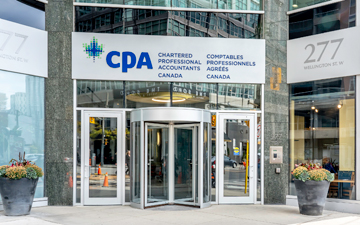CPA Canada reduces operating budget with staff cuts due to accounting profession standoff

National organization has run two deficits in the past five years, says changes needed to ensure long-term success in challenging operating environment
TORONTO, Feb. 19, 2023 – Chartered Professional Accountants of Canada laid off 20 per cent of its staff this past week in a move that will reduce its multi-million dollar operating budget. The national organization, which had about 400 employees before the cuts, has run two budget deficits in the past five years. Pamela Steer, the president and CEO of CPA Canada, told employees that “the impending withdrawals of CPA Ontario and CPA Quebec leave us in a challenging operating environment.”
The layoffs mark the first major changes resulting from the current standoff with the two largest provincial associations over a new Collaboration Accord. The provincial accounting bodies regulating chartered professional accountants in Ontario and Quebec announced in June 2023 an intended split with CPA Canada over the future governance of the Canadian accounting profession.
In September 2023, CPA Ontario announced that the three accounting bodies had reached an agreement, separate from the Collaboration Accord, that would ensure the “educational journey” of students would not be impacted. CPA Canada would continue to develop the curriculum and examinations for the CPA program and the provinces would be responsible for the delivery of the CPA professional education program.
Changes made to the presentation of CPA Canada’s financial statements
In fiscal 2022-23, CPA Canada “implemented a service-driven view in aligning the financial reporting for CPA Canada with our five core priorities,” naming new financial categories such as “pre-certification education" and "thought leadership & professional development." The changes, some of which overlap with past budget lines, make it difficult to compare year-over-year results in the organization’s annual reports.
CPA Canada also revised the way its administrative expenses are broken out in its financial reports to align with its public-facing programs, allocated based on salaries, “to provide greater insight into our expenses.” In previous years, information regarding compensation could be found under “finance and administration.”
Similar organizations such as CPA Australia and the Institute of Chartered Accountants in England and Wales include information regarding staff salaries in its annual reports. CPA Australia, for example, includes a lengthy section on compensation in its annual reports, including fee bands, and separates staff salaries under Expenditures (employee benefits) in its financial statements. In 2022, CPA Australia spent $81.6-million on “employee salaries and other benefits.” The ICAEW publishes not only pay bands but the compensation of its CEO.
A look at the operating budget of CPA Canada
According to its five most recent annual reports, overall revenue at CPA Canada has hovered around $130m, with member fees generating about $70m, whereas expenses have increased from $122m to $133m. The organization has posted two deficits within the past five years. CPA Canada posted a particularly large deficit of $11.25 million in the most recent fiscal year, which ended March 31, 2023.
The deficit included $8.77-million in spending on “strategic initiatives.” CPA Canada withdrew the spending from a $21-million fund “internally restricted for strategic initiatives,” which now sits at $12.3-million.
The fund was established in 2021-22 to finance various projects and initiatives, most notably the Coalition of Canadian Champions Escrow Trust, which, according to the prior year’s annual report, was expected to cover costs related to the Montreal centre of the International Sustainability Standards Board; an independent review of standard setting in Canada; the start-up costs for the Canadian Sustainability Standards Board; and various foundational business costs such as cybersecurity.
The organization also allocated increased education costs of $4.4-million associated with the new certification program, which accounted for a large part of the deficit. Also contributing to the deficit were a rise in insurance premiums and a decrease in investment income due to unfavorable market conditions.
No changes anticipated in current path
According to the Globe and Mail, Ms. Steer told CPA Canada employees in an internal memo “that, despite many discussions and continuing efforts, ‘it has become clear that Ontario and Quebec will not change their current path,’ and that, as of December, 2024, the two organizations will leave CPA Canada.”
Spokespeople for both provincial organizations expressed sympathy for the employees laid off by CPA Canada, whom Ms. Steer characterized as “good people who have worked hard on behalf of our profession and CPAs across Canada.”
In our five-part series, CPA Standoff, the two provincial organizations agreed on three key issues at the heart of the dispute: a recognition that oversight of the profession rests with the provinces and territories; governance changes to allow that oversight; and increased financial transparency from CPA Canada regarding the funds remitted to it.
By Canadian Accountant staff. Images: iStock.











(0) Comments